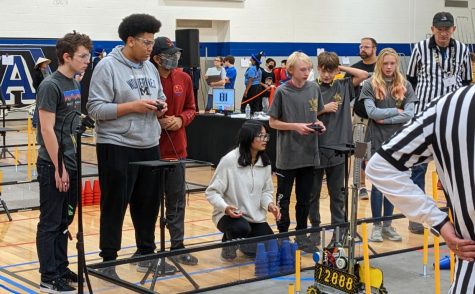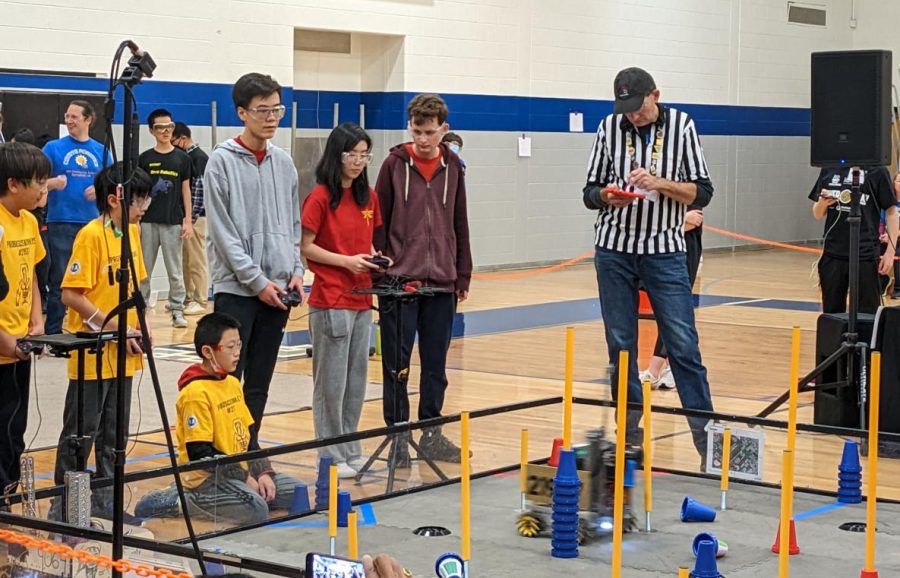Prayers and Duct Tape: Engineering the Future through Robotics
Firefly team members, sophomores Daniel Cao and Claire Ke and senior captain Will Terrell, steer their robot to pick up plastic cones to place them on different levels of poles. The FTC challenge is different each year.
January 12, 2023
The crowd holds their breath as the round begins. The robots move by themselves. Students cheer as a robot places a cone onto a pole to score a point. A bell rings and students dart forward to grab the controls, starting a fiercely competitive round.
When the match ends, teams return to the “pit,” a workspace for teams. “It’s definitely organized chaos,” Paradigm Break team captain, senior Anna Rosner said, “It’s very energizing because you’re surrounded by all these people who are all trying to get their robot working.”
Throughout the pit, students work tirelessly to fix or improve their robots between matches. Teams help each other, giving tools and advice freely.
This is the world of FIRST robotics. The Albemarle robotics club is made up of four different FIRST Tech Challenge (FTC) teams that compete individually in challenges. FTC is a worldwide competition where teams build and code a robot to compete in a different game every year, which includes both an autonomous, where the robot drives without any human input, and driver-operated portion.
The goal of robotics is to design and code a unique robot from scratch to complete each year’s new FIRST Challenge.
Teams drive around the field, a small arena covered in foam tiles. This year, teams must pick up plastic cones and put them on four levels of poles. Teams earn points by parking in a specified spot during the autonomous or by placing cones on poles. The taller the pole, the more points teams score.
Teams do their best to create a robot that earns the most possible points, but that process starts with a simple robot. “We’re trying to build a robot that is the minimum viable product, and then build off of that iteratively,” Firefly team co-captain senior William Terrell said. Teams construct a robot that they can build upon and improve through the season.

Since the teams go to multiple competitions a year, they begin the process by building a robot from scratch, starting with individual parts. When they have a completed robot, they “see what goes right, what goes wrong,” Deep Blue team captain sophomore Emmett Lach said.
Once they have identified any issues, the team will revise their design before testing it in the next competition, he said. Applying the engineering process is just one of the many skills students learn as a part of a robotics team.
“[Robotics] is so hands-on. Even if you’re taking an engineering class at school, you won’t be doing nearly as much hands-on building as if you were to do robotics,” Lach said.
Students don’t learn only hard skills, but soft skills as well. “We have to decide what we want to make, how we’re going to make it, and all those decisions by ourselves,” Terrell said, “That’s a big leadership challenge.”
Teams have also struggled with time management, funding, and “finding a balance between getting stuff done and having fun,” when preparing for competitions, Vertigo team co-captain, senior Steven Siadaty said. All these skills are applicable outside of robotics as well.
Robotics also creates an opportunity for teamwork and teaches the ability to work with a wide variety of people, Siadaty said. “There’s a bunch of different people on the team that I would have never seen otherwise,” he said, “but we all can come together for this.”
Rosner recalled a time when an electronic part broke on the robot and the team pulled together to fix it. “When it comes to working in a team, I feel like it’s one of the greatest team experiences that you can get,” she said.
This experience goes beyond working within a singular team. Rosner recalled her team’s last competition, where they had forgotten all their electronics. Other teams at the competition helped out, making sure the team got what they needed. Rosner said that, “if we’re ever the team that can help someone out, of course we’re going to.”
Rosner is currently working to expand robotics into elementary and middle schools in the area. She has met with the County budget forum to talk about funding more programs because she feels that exposure to STEM at a young age is important, especially for girls. Rosner said it’s easy to look at a male-dominated field like robotics when not exposed to it at a young age and think, “there’s no one like me in this group.”
Rosner acknowledged that robotics can be intimidating and can look inaccessible for people, but, “when it comes down to what we do, it’s just a lot of duct tape and prayers, but it’s really fun.”
All four AHS teams will be competing alongside 35 other teams in the big gym on Jan. 15 from 10:45 AM to 5:00 PM. This free-to-watch competition is a way to show support for the teams and to help them reach the state championship this year.


